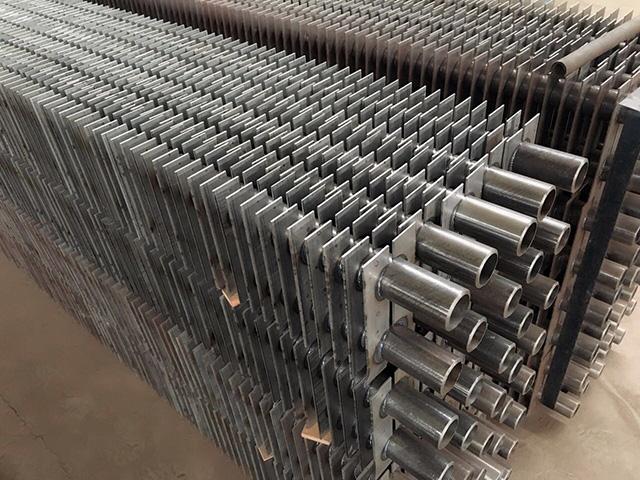Lord Fin Tube-Rectangular Finned Tubes

1. Rectangular Finned Tubes
Rectangular finned tubes are specialized heat transfer components engineered to maximize thermal efficiency in various industrial applications. These tubes feature rectangular-shaped fins attached to the outer surface of a base tube, significantly increasing the heat exchange surface area. The enhanced surface area facilitates more effective heat transfer between the fluid flowing inside the tube and the external environment.
The unique rectangular fin configuration provides approximately 15-25% more surface area compared to circular fins of similar dimensions, making them particularly effective in applications where space constraints and thermal performance are critical factors.
Technical Insight: Rectangular finned tubes typically achieve heat transfer coefficients between 50-150 W/m²K in air applications, significantly higher than bare tubes which typically range from 10-30 W/m²K under similar conditions.
2. Rectangular Finned Tubes Structure and Materials
The structural design of Rectangular Finned Tubes consists of a primary tube (typically circular or square) with rectangular fins attached perpendicularly to its surface. The fins are precisely spaced to optimize airflow and minimize pressure drop while maximizing heat transfer.
Carbon Steel
Standards: ASTM A179, A192, A210
Max Temperature: 450°C
Applications: Boilers, economizers, general heat exchangers
Advantages: Cost-effective, good thermal conductivity
Stainless Steel
Grades: 304, 316, 321, 310
Max Temperature: 650°C
Applications: Corrosive environments, high-temperature processes
Advantages: Excellent corrosion resistance
Alloy Steel
Grades: T5, T11, T22, T91
Max Temperature: 600°C
Applications: High-pressure boilers, superheaters
Advantages: High temperature strength
| Material Combination | Maximum Service Temperature (°C) | Thermal Conductivity (W/m·K) | Pressure Rating (MPa) | Typical Applications |
|---|---|---|---|---|
| Carbon Steel Tube / CS Fins | 450 | 45-55 | 10-15 | Air Heaters, Economizers |
| Stainless Steel 304 Tube / SS Fins | 650 | 15-20 | 12-18 | Chemical Processes, Food Industry |
| Stainless Steel 316 Tube / SS Fins | 650 | 15-20 | 12-18 | Marine Applications, Chloride Environments |
| Alloy Steel T11 Tube / CS Fins | 550 | 35-40 | 15-25 | Boiler Systems, High Temp Applications |
3. Welded Fin Attachment Manufacturing Process
The welded fin attachment method is the most advanced and reliable manufacturing technique for rectangular finned tubes, providing superior mechanical strength and thermal performance. This process involves precision resistance welding of individual fins to the base tube surface.
Advantages of Welded Fin Technology
- Excellent mechanical bond strength withstands thermal cycling and vibration
- Superior thermal contact with minimal contact resistance
- Suitable for high-temperature and high-pressure applications
- Compatible with a wide range of material combinations
- Long-term reliability in demanding industrial environments
Welding Process Steps
Surface Preparation
Base tube surface is cleaned and prepared to ensure optimal weld quality and fin adhesion
Fin Positioning
Rectangular fins are precisely positioned on the tube surface using automated fixtures
Resistance Welding
High-current electrical pulses create localized welds at multiple contact points
Quality Inspection
Each weld is inspected for integrity using non-destructive testing methods
| Welding Parameter | Typical Range | Effect on Performance | Quality Control Measures |
|---|---|---|---|
| Welding Current | 5-15 kA | Determines weld penetration and strength | Continuous monitoring and calibration |
| Weld Pressure | 2-8 MPa | Affects contact resistance and bond quality | Pressure sensors and feedback control |
| Weld Duration | 50-200 ms | Controls heat input and metallurgical changes | Precise timing circuits |
| Weld Spacing | 15-40 mm | Balances structural integrity and thermal performance | Laser positioning systems |
4. Comparison with Square Finned Tubes
| Feature | Rectangular Finned Tubes | Square Finned Tubes |
|---|---|---|
| Surface Area Increase | 8-12x base tube | 6-9x base tube |
| Heat Transfer Efficiency | High (15-25% better than square) | Moderate |
| Airside Pressure Drop | Medium | Low-Medium |
| Structural Strength | Excellent | Good |
| Manufacturing Complexity | Medium | Low |
| Material Utilization | 85-90% | 75-80% |
| Fouling Resistance | Good | Better |
| Space Efficiency | Superior | Good |
| Typical Applications | Air Coolers, Heat Recovery, Compact Exchangers | General HVAC, Basic Heat Exchangers |
Rectangular Finned Tubes Advantages
- Higher surface-to-volume ratio for improved heat transfer
- Better space utilization in compact heat exchanger designs
- Superior thermal performance in air-cooled applications
- Enhanced structural stability in high-pressure applications
- Optimal for applications requiring maximum heat transfer in limited space
Square Finned Tubes Advantages
- Simpler manufacturing process and lower production costs
- Better resistance to fouling in dirty environments
- Easier cleaning and maintenance
- Lower airside pressure drop in some configurations
- Suitable for general-purpose applications with moderate heat transfer requirements
Technical Advantage: Rectangular finned tubes provide up to 25% more heat transfer surface in the same frontal area compared to square finned tubes, making them ideal for compact heat exchanger designs where space optimization is critical.
5. Rectangular Finned Tubes Application
Rectangular finned tubes are deployed across numerous industries where efficient heat transfer is critical to process performance and energy efficiency.
Power Generation
Air-cooled condensers, feedwater heaters, and turbine oil coolers in thermal power plants
Chemical Processing
Process gas coolers, reactor feed effluent exchangers, and distillation condensers
Oil & Gas
Gas coolers, lubricant coolers, and compressor intercoolers
Waste Heat Recovery
Recuperators and regenerators capturing thermal energy from exhaust streams
Industrial Boilers
Economizers, air preheaters, and superheaters in steam generation systems
Petrochemical
Process heaters, reformer units, and cracking furnace applications
| Industry | Specific Application | Typical Tube Material | Typical Fin Material | Operating Temperature Range |
|---|---|---|---|---|
| Power Generation | Air Cooled Condensers | Carbon Steel | Carbon Steel | 50°C - 400°C |
| Chemical Processing | Process Gas Coolers | Stainless Steel 316 | Stainless Steel 316 | 100°C - 650°C |
| Oil Refining | Heater Convection Sections | Alloy Steel T11 | Carbon Steel | 300°C - 550°C |
| Waste Heat Recovery | Exhaust Gas Economizers | Carbon Steel | Carbon Steel | 200°C - 450°C |

